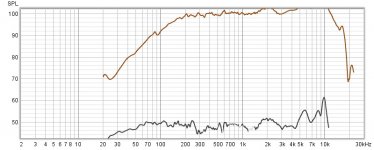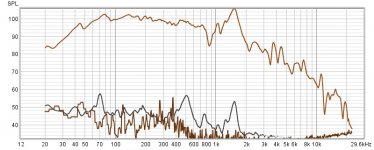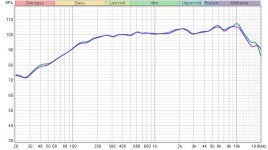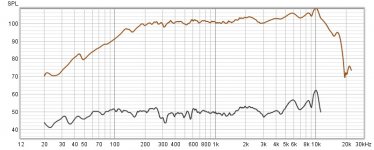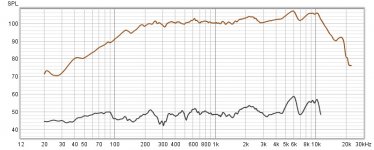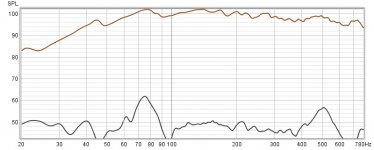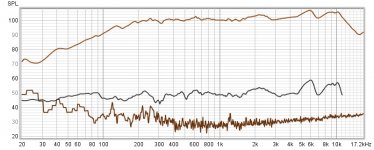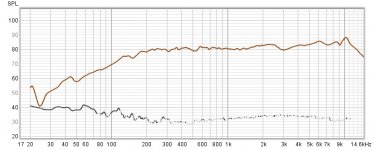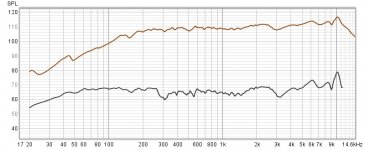I made a strange observation today, potentially involving my 5 layer cld baffle.
Two measurements, on axis, both at 100db/12".
The first is of my Peerless hds 4" midbass mounted on on my 5 layer cld baffle and the second is of my 10" peerless xxls subwoofer. Can anyone make sense of this? Am I missing something? Is it even possible? The brown trace on the sub is the noise floor.
Two measurements, on axis, both at 100db/12".
The first is of my Peerless hds 4" midbass mounted on on my 5 layer cld baffle and the second is of my 10" peerless xxls subwoofer. Can anyone make sense of this? Am I missing something? Is it even possible? The brown trace on the sub is the noise floor.
Attachments
Last edited:
Your question seems to be whether the movement of the CLD baffle somehow cancels HD measured from the driver.
If that were so, it implies non-linear movement of the panel. While this is possible, do you think the CLD itself would encourage this? I'm not inclined to think that.
Do you have another shot of it where it is worse?
If that were so, it implies non-linear movement of the panel. While this is possible, do you think the CLD itself would encourage this? I'm not inclined to think that.
Do you have another shot of it where it is worse?
You are rolling off your midrange significantly at low frequencies which may be keeping the cone deflection in the linear region. Looking at the cone during the sweep should tell you if this is the case.
This is with the 4" midranges being used wide open with no high or low pass filter applied. Remember how small a 4" driver is🙂. The two lines would typically converge at around 40 or 50hz with a really good 4" woofer. HD is 27db below the fundamental at 20hz? Huh?
1. Pair matching
2. Midbass right channel hd
3. Midbass left channel hd
4. subwoofer hd
6. All measurements on axis 100db/12"
1. Pair matching
2. Midbass right channel hd
3. Midbass left channel hd
4. subwoofer hd
6. All measurements on axis 100db/12"
Attachments
Last edited:
My next experiment will be to run these at 80db, 90db, 100db(which I've already done), and 110db. If there is an actual HD cancelation occurring due to the baffle, it shouldn't change much from the lowest amplitude to the highest.
Last edited:
Okay, now these are some strange results. At 65db, the 4" driver is doing exactly what you would expect from a 4" driver. The thd and the fundamental converge at about 60hz. This is most likely due to the driver not providing enough force to activate the cld baffle.
What happens next has to be due to the heavy five layer cld baffle getting activated by the increasing force. Can anyone think of a different reason this could be happening?
1. 65db
2. 80db
3. 92db
4.100db
5.110db
What happens next has to be due to the heavy five layer cld baffle getting activated by the increasing force. Can anyone think of a different reason this could be happening?
1. 65db
2. 80db
3. 92db
4.100db
5.110db
Attachments
There is just no way this could be happening. It must be an artifact of the measurement system(Umik-1 and of course REW). I'm going to look into it further, but in the mean time, please take these measurements with a grain of salt. It just doesn't make any sense. At 110db, these things should be distorting like crazy from 100hz and down. I'll post more if I can sort things out. These results are magical, and I don't believe in magic🙂
Last edited:
No, but based on the results, it shouldn't get better and better with increasing amplitude. I can see the cld baffle having somewhat of an effect, but not like this.Have you measured the distortion without the baffle?
Last edited:
I sympathize... measurement errors can be SO frustrating... In the old days it was a loose connection, or a bad cable... now it is some damn setting buried down in an ASIO driver.
Hifijim
But the strange thing is that this is a USB mic that passes the digital signal from itself through the computer and the reclocker, and only gets converted to analog at the output of the digital crossovers. There is no soundcard involved. So maybe the only place the problem could be occurring is in the A/D conversion of the usb mic itself? Hard to say. In really complex systems, the problem could be hiding anywhere. I do have a normal analog Dayton mic, but I misplaced the phantom power source and cable.
But the strange thing is that this is a USB mic that passes the digital signal from itself through the computer and the reclocker, and only gets converted to analog at the output of the digital crossovers. There is no soundcard involved. So maybe the only place the problem could be occurring is in the A/D conversion of the usb mic itself? Hard to say. In really complex systems, the problem could be hiding anywhere. I do have a normal analog Dayton mic, but I misplaced the phantom power source and cable.
Last edited:
When I was having problems, I discovered it was not the measurement software that was in error, it was the source signal... I was using Windows Media player, and it did not have a flat frequency response...
Your situation is probably different. Off the top of my head, I don't know what could be going on.
Your situation is probably different. Off the top of my head, I don't know what could be going on.
What is measurement distance? I think that we see only noise, not distortion. Plot H2, H3 etc. separately, THD doesn't tell much!
Try looking at the spectrum of a single frequency sine wave to debug your issue. You should be able to see the fundamental and the harmonic peaks sticking up out of the noise floor and compare the levels of the fundamental and distortion components. You have a second order acoustic roll off so excursion should be constant below ~150Hz, but due to the roll off of the fundamental distortion should rise below 150Hz. I'm not familiar with REW, but is there an option in there to normalize THD to the fundamental that you might have checked?
There is a box that you can't uncheck, that say's "Limit normalization to 30db below peak. This prevents boosting of distortion when levels are very low and outside of the passband of the loudspeaker." Could that explain why it stays 30 db below the fundamental at around 20hz? I don't don't have any idea why it doesn't allow you to uncheck it.
What is measurement distance? I think that we see only noise, not distortion. Plot H2, H3 etc. separately, THD doesn't tell much!
The distance was 12" for all measurements. I didn't show individual distortion components because with the crazy, unsubtle results I was getting, I felt that subtleties were kind of irrelevant. Noise floor on the the other hand, should definitely have been included. Rush hour traffic off in the distance would have definitely contaminated the measurements below 100hz, especially in the lowest frequencies
- Home
- Loudspeakers
- Multi-Way
- Is the cld baffle construction canceling out the 4" midbass HD? t
